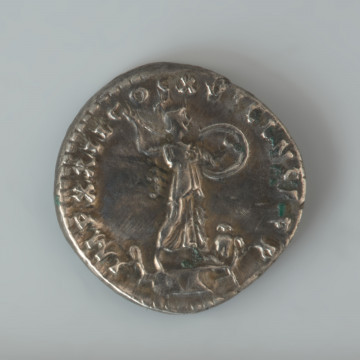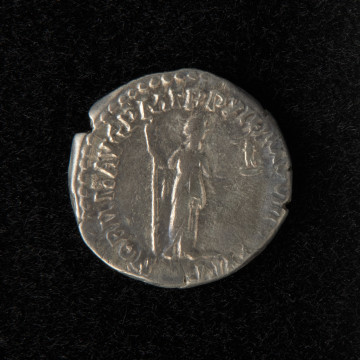
Denarius of Domitian
92 — 93
National Museum in Szczecin
Part of the collection: Antiquity
The denarius, a silver coin of the Roman Republic minted ca. 130 BC, was found in the vicinity of Kołobrzeg-Mirocice during 1857–1858 railway construction works. Denarii, one of the earliest coins recorded on the Polish territories, were issued during the late Roman Republic period (3rd–1st centuries BC). They are much more uncommon in the Western Pomerania region than the coins of the Empire period, those dated to the 3rd century in particular. The Kołobrzeg-Mirocice denarius’ obverse depicts the head of the Roma goddess (the symbol of Rome) with a winged helmet, turned to the right. The inscription M Varg is on the left side, while on the right side there is a six-pointed star resembling the Roman number XVI, meaning 16 aces. Around the rim there is a row of dots. The abbreviation M Varg stands for the name “Marcus Vargunteius”, one of the three monetary officials of the Roman Republic responsible for issuing coins in 130 BC; they were referred to as tresviri aere argento auro flando feriundo, meaning “the three men for casting (and) minting bronze, silver (and) golden (coins)”, and the shorter version of this title was tresviri monetales. The obverse depicts the figure of Jupiter turned to the right in a quadriga (a Roman, two-wheeled chariot). He holds a bolt of lightning and reins in his left hand and a branch in his right hand. Below the figure is the inscription ROMA. Given that the coins were present in various hoards, it is known that they were used even for 200–300 years.
Monika Witek
Author / creator
Dimensions
cały obiekt:
Object type
exchaneg media; money; coin; denarius
Technique
punching
Material
silver
Creation / finding place
Owner
Muzeum Narodowe w Szczecinie
Identification number
Location / status

92 — 93
National Museum in Szczecin

177 — 192
National Museum in Szczecin

210 — 213
National Museum in Szczecin
DISCOVER this TOPIC
Castle Museum in Łańcut
DISCOVER this PATH
Educational path